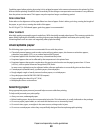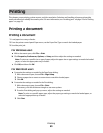Tips on using transparencies
Print samples on the transparencies being considered for use before buying large quantities.
When printing on transparencies:
• Feed transparencies from the standard 250-sheet tray or the multipurpose feeder.
• Use transparencies designed specifically for laser printers. Check with the manufacturer or vendor to ensure
transparencies are able to withstand temperatures up to 175°C (350°F) without melting, discoloring, offsetting,
or releasing hazardous emissions.
Note: Transparencies can be printed at a temperature up to 180°C (356°F) if Transparency Weight is set to Heavy
and Transparency Texture is set to Rough. Select these settings using the Embedded Web Server, or from the
printer control panel Paper menu.
• To prevent print quality problems, avoid getting fingerprints on the transparencies.
• Before loading transparencies, fan the stack to prevent sheets from sticking together.
• We recommend Lexmark part number 70X7240 for letter-size transparencies and Lexmark part number 12A5010
for A4-size transparencies.
Tips on using envelopes
Print samples on the envelopes being considered for use before buying large quantities.
When printing on envelopes:
• Use envelopes designed specifically for laser printers. Check with the manufacturer or vendor to ensure the
envelopes can withstand temperatures up to 210°C (410°F) without sealing, wrinkling, curling excessively, or
releasing hazardous emissions.
Note: Envelopes can be printed at a temperature up to 220°C (428°F) if Envelope Weight is set to Heavy and
Envelope Texture is set to Rough. Select these settings using the Embedded Web Server, or from the printer
control panel Paper menu.
• For the best performance, use envelopes made from 90 g/m
2
(24 lb bond) paper. Use up to 105 g/m
2
(28 lb bond)
weight for envelopes as long as the cotton content is 25% or less. All-cotton envelopes must not exceed
90 g/m
2
(24 lb bond) weight.
• Use only new envelopes.
• To optimize performance and minimize jams, do not use envelopes that:
– Have excessive curl or twist
– Are stuck together or damaged in any way
– Have windows, holes, perforations, cutouts, or embossing
– Have metal clasps, string ties, or folding bars
– Have an interlocking design
– Have postage stamps attached
– Have any exposed adhesive when the flap is in the sealed or closed position
– Have bent corners
– Have rough, cockle, or laid finishes
• Adjust the width guides to fit the width of the envelopes.
Note: A combination of high humidity (over 60%) and the high printing temperature may wrinkle or seal envelopes.
Printing
65


















